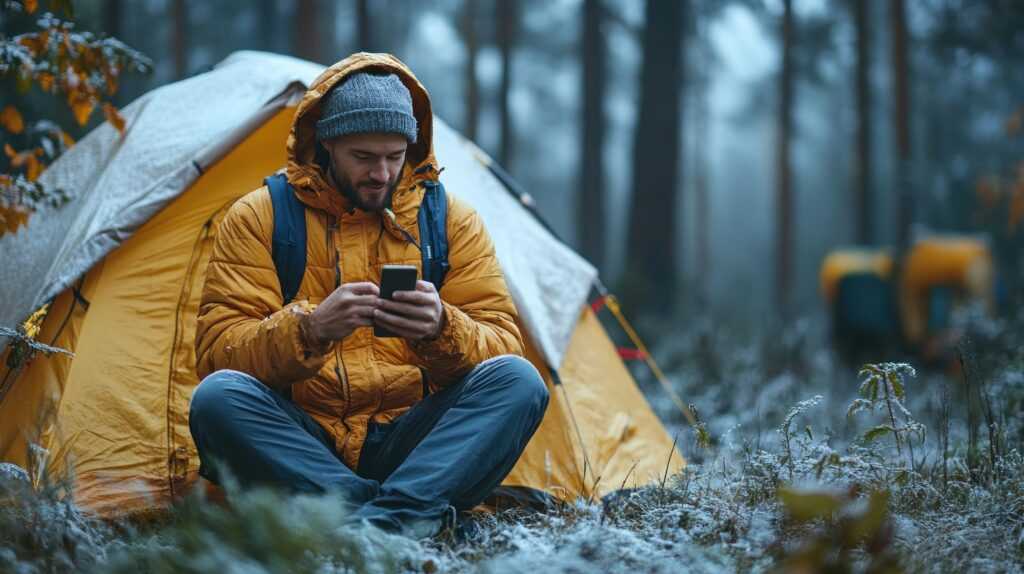Camping abroad is a dream for many. But navigating foreign wilderness presents a unique challenge: staying connected for safety, navigation, and sharing your journey. While going completely off-grid is an option, the right communication tools are what separate a stressful ordeal from a seamless adventure. Here are the best tools to keep you connected while camping abroad.
1. eSIMs and Local SIM Cards
For most international travelers, this is the gold standard for staying connected. An eSIM (embedded SIM) enables you to activate a plan from a local carrier digitally.
For campers, this is a game-changer. You can research and purchase a data plan before you even board the plane, ensuring you have connectivity the moment you land.
Why it’s great for camping:
- Immediate connectivity: Hit the ground running with maps, translation apps, and campground booking sites ready to go.
- Wide coverage: Many local carriers have extensive networks that cover popular national parks and rural areas.
- Cost-effective: Local data plans are almost always cheaper than international roaming fees from your home carrier.
For campers heading to specific regions, it’s wise to get a plan tailored to that area. For instance, securing a Japan eSIM before a camping trip through Hokkaido or the Japanese Alps guarantees you have access to high-speed data for reliable trail maps and weather updates in remote mountainous regions.
2. Satellite Messengers
A thorough risk assessment is a non-negotiable part of any camping trip, especially when venturing off-grid abroad. This is where a satellite messenger becomes your most critical piece of gear. These rugged devices use satellite networks to send and receive messages and your GPS location from anywhere on the planet, far beyond the reach of cell towers.
Why it’s great for camping:
- True off-grid communication: Essential for backcountry camping, remote hikes, and any situation where cell service is nonexistent.
- Emergency SOS: You can seek help in just a push of a button and rescuers can locate your exact coordinates.
- Check-in features: Allow loved ones to follow your journey and receive “I’m okay” messages, providing peace of mind for everyone.
While popular European campsites in regions like The Netherlands, Spain’s Costa Dorada, or the French Riviera often have good coverage, a satellite messenger is indispensable for exploring the remote trails surrounding areas like Corsica’s Porto Vecchio.
Remember that these devices require a clear view of the sky to work. For best performance, avoid using them in deep canyons or under a thick forest canopy. When sending a message, place the device on a rock or hold it away from your body.
3. Portable Wi-Fi Hotspots (MiFi)
A portable Wi-Fi hotspot, or MiFi device, acts as a personal bubble of internet access. You insert a local SIM card (or use a global plan), and the device creates a Wi-Fi network that multiple devices (your phone, your partner’s tablet, etc.) can connect to.
Why it’s great for camping:
- Connect multiple devices: Perfect for couples, families, or groups camping together.
- Better battery life: Using a dedicated hotspot can save your phone’s battery, as the MiFi device handles the data connection.
- Flexibility: You can often choose from various data plans, including high-capacity options for uploading photos and videos.
For the best signal at your campsite, place your MiFi device high up inside your tent or on a nearby picnic table. A small, portable power bank can keep it running all day and night, ensuring you have a constant connection without draining your other devices.

4. Offline-Capable Apps
Your smartphone is a powerful tool, even without a signal. Pre-download the right smartphone apps and turn your device into a comprehensive guide and survival tool.
Download regional maps over Wi-Fi to use turn-by-turn navigation without a data connection. Language packs can help you translate signs and menus, or converse with a local ranger. The Red Cross offers offline first aid guides that are invaluable in an emergency.
Organize all your essential offline apps in a single folder on your phone’s home screen labelled “CAMP” or “OFFLINE.” This prevents frantic searching with a weak signal. Also, remember to download your maps and language packs before you leave home, as reliable Wi-Fi can be hard to find once your journey has begun.
5. Two-Way Radios or Walkie-Talkies
For group camping, especially in areas with spotty cell service, a two-way radio or walkie-talkie is incredibly useful. They are perfect for coordinating between hikers, communicating between tents at a large campsite, or keeping in touch with kids exploring the immediate area.
Why it’s great for camping:
- Instant, free communication: No per-minute costs or data usage.
- Reliable over short distances: They work directly between devices, making them perfect for campsite and trail use where cell service is weak but you’re within a few miles of each other.
- Durable and long-lasting: Many models are weather-resistant and have excellent battery life.
Before you head out, agree on a primary channel and a backup channel with your group in case of interference. For clearer communication and better range, hold the radio vertically and speak clearly and concisely, pausing a moment after you press the “push-to-talk” button before beginning your message.
Bottom Line
Staying connected while camping abroad isn’t about being glued to a screen; it’s about safety, convenience, and enhancing your experience. Combining a primary data solution like an eSIM with a safety device like a satellite messenger and robust offline apps enables you to explore the world’s most beautiful landscapes with confidence. So, pack your gear, choose your tools, and answer the call of the wild, wherever it may lead you.


 Dominic Reed brings his extensive experience in outdoor survival and adventure sports to Terra Tactician Tactics, where he plays a crucial role in the platform's development. With a background in outdoor education and a deep love for wilderness exploration, Dominic is committed to creating content that inspires and informs readers. He specializes in writing articles on survival skills, advanced camping techniques, and gear recommendations, drawing from his own adventures and hands-on expertise. Dominic's practical approach and engaging storytelling help readers prepare for their outdoor pursuits, ensuring they are well-equipped for whatever nature throws their way.
In addition to his writing, Dominic actively collaborates with the team to expand the platform's reach and impact. He is passionate about connecting with the outdoor community and sharing his knowledge with those eager to learn more about survival tactics and adventure sports. His contributions have been instrumental in positioning Terra Tactician Tactics as a go-to resource for enthusiasts seeking to elevate their outdoor experiences. Dominic's dedication to the project is driven by his belief in the transformative power of nature and his desire to help others develop a deeper connection to the wild.
Dominic Reed brings his extensive experience in outdoor survival and adventure sports to Terra Tactician Tactics, where he plays a crucial role in the platform's development. With a background in outdoor education and a deep love for wilderness exploration, Dominic is committed to creating content that inspires and informs readers. He specializes in writing articles on survival skills, advanced camping techniques, and gear recommendations, drawing from his own adventures and hands-on expertise. Dominic's practical approach and engaging storytelling help readers prepare for their outdoor pursuits, ensuring they are well-equipped for whatever nature throws their way.
In addition to his writing, Dominic actively collaborates with the team to expand the platform's reach and impact. He is passionate about connecting with the outdoor community and sharing his knowledge with those eager to learn more about survival tactics and adventure sports. His contributions have been instrumental in positioning Terra Tactician Tactics as a go-to resource for enthusiasts seeking to elevate their outdoor experiences. Dominic's dedication to the project is driven by his belief in the transformative power of nature and his desire to help others develop a deeper connection to the wild.